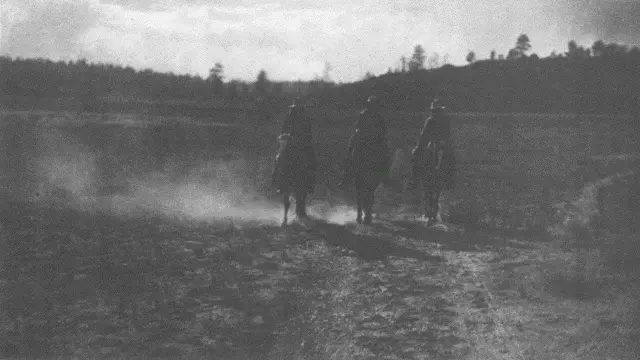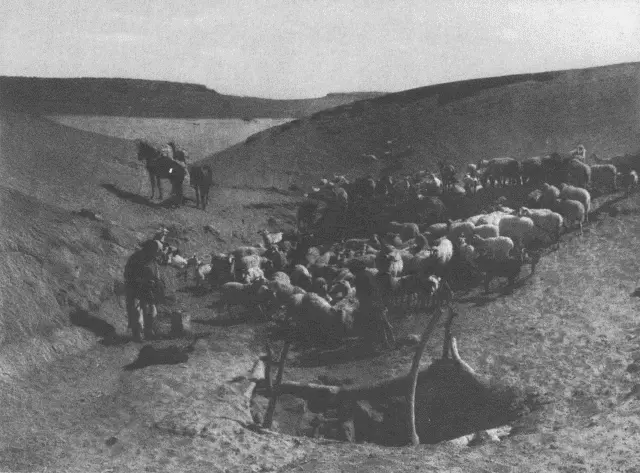As already mentioned, the performance of this ceremony extends through a period of four days and four nights. The day preceding is spent in preparation: the head of the family of the sick person makes ready for a feast, and helpers build a corral of piñon and spruce branches. This corral is circular, about forty yards in diameter and six feet high, with an opening at the east. To the west, close to the fence, is the medicine kozhán. The latter part of each morning of the four days is spent by the medicine-man and his assistants in the kozhán, where a dry-painting of blue, black, yellow, and red earths is made in the shape of a snake lying in a circle with a space between the head and the tail. The circle is about six feet in diameter, and within it are represented numerous animals: the bear, turkey, deer, eagle, buffalo, elk, badger, gopher, and others. A decoction is mixed in an earthen bowl and the patient is summoned. Sand from the various parts of the painting are sprinkled on the corresponding parts of his body, and the medicine mixture is given him to drink.
The night portions of the ceremony begin shortly after dark. The medicine-man and any persons who know the songs gather in the kozhán and sing, accompanied with a drum made of a basket inverted over a hole in the ground and covered with a buffalo skin, the head toward the east. The hole represents the pit in the legend, the basket the one the girls were weaving, and a figure interwoven in the latter symbolizes the butterfly of the story. The beating of the drum is varied at intervals by the use of a leg-bone of a mountain sheep rasped quickly over a notched stick. Any men of the tribe may enter the kozhán, and even a white man who is well known. The songs consist of recitals of the powers of the medicine-man and invocations to the various animals, as the bear, snake, and mountain sheep. Some of the songs consist merely in naming the parts of the animal's body, while others are supposed to be those used by the Bear and the Snake in the legend. After singing these songs for about three hours, with intervals of rest, the dancing begins. On each side of the enclosure are three fires. Behind these on the north side are the men, on the south the women; thus a large open space is bounded by the two lines of fires, the kozhán, and the opening of the corral. Two women walk slowly into this space, their heads modestly bent. They stop, and a young man approaches to ascertain with whom they would dance. He then finds the desired persons, takes each by the arm, and drags him out. The men always feign unwillingness to go. In the meanwhile other pairs of women have come out and other young men become busy finding partners for them. As a rule they dance in groups of four, men and women facing each other and moving backward and forward five or six steps. As the dance progresses the man is likely to lay his hands upon the woman's shoulders, but modesty forbids her a similar liberty. The same pair may remain dancing together throughout the night, or they may cease when either desires. On the first night the dancing continues until about midnight; the second, an hour or two longer; the third, until well toward dawn; the fourth, until sunrise.

Jicarillas
On the last night the top of a small spruce tree, tipped with eagle down, is planted near the door of the kozhán, and a new element in the dancing is introduced. About midnight, before any dancing has been engaged in, the ceremonial dancers enter from two dressing kozhán some two hundred yards east of the corral. These consist of two parties. The first, eight in number, enter in single file, preceded and followed by a man in everyday costume. These dancers, called Tsannatí̆, are nude, save for the breech-cloth, with body and face painted in white and black, and the hair hanging loose. Immediately following them are the Chanzhiní̆, six in number, accompanied by four keepers, two in front and two behind. The six are nude, the bodies painted solid white with six black stripes encircling them. The hair is painted white and is done up into two long, stiff braids, which project from the sides of the head like a pair of horns. The faces are hideously made up to represent clowns, as indeed their name signifies. In dancing, the Chanzhiní̆ and Tsannatí̆ do not take steps, but shuffle sidewise, locomotion being effected by means of a sort of exaggerated shivering of the legs. This movement is common to Plains tribes in many of their dances. The whole line of dancers proceed with their peculiar motion into the kozhán and around the fire, passing before the patient, the Chanzhiní̆ all the while uttering hoarse, animal-like cries. Their utterances are always coarse and obscene, causing much merriment, which is supposed to aid the patient in casting off his illness. After passing through the kozhán the Tsannatí̆ form in line outside and with their feet keep time to the singing and drumming, while the others break ranks and in a promiscuous throng pass before the spectators, first on the men's side, then on the women's. Just before their departure from the corral any woman who feels an indisposition may crouch in their path near the gate, facing the west, and the Chanzhiní̆ one by one leap over her, first from the east, then from the other three directions, ever continuing their hoarse cries.
These characters make their appearance four times during the course of the night, the spectators dancing during the intervals. After their last exit dancing continues until shortly before sunrise; then the medicine-man and the singers arise, and, forming a circle about the fire in the centre of the kozhán, sing a number of songs. A maiden is summoned from the gathering to carry a basket of sacred meal, and the medicine-man, taking up the top of the spruce tree, passes out of the enclosure toward the rising sun, followed by the maiden, the patient, the singers, and any who may be afflicted with a bodily ailment. At a distance of about a hundred yards the medicine-man stops and plants the little spruce tip, to which the disease is now supposed to have been transferred, under a tree, sprinkling over it quantities of the sacred meal. Then each of the others, the patient leading, steps forward, throws a pinch of the meal on the tree, and passes on, always facing the east. When the last one has thus passed, the procession stops, everybody holds his blanket ready, and on signal from the medicine-man, just as the sun appears, gives it a shake and runs at full speed to the kozhán and around the fire. Thus is disease shaken out and the pursuit of the evil spirits of sickness eluded.

Jeditoh - Navaho
It is interesting to note the difference between the Apache of Arizona and the Jicarillas in their assignment of colors to the cardinal directions. The former invariably associate black with the east, blue with the south, yellow with the west, and white with the north.
Mythology - Creation Myth
Table of Contents
In the beginning all people, birds, and beasts were far beneath this earth, somewhere in the darkness; there was no sun, no moon. It was not a good place in which to live, because of the darkness. After a time came Chunnaái, the Sun, and Klĕnaái, the Moon. They directed the people to leave the world of darkness, showing the way they were to go by passing up through a rift in the sky. But the sky was so far above that the people knew of no way to reach it, so they made a pile of sand in the form of a mountain, and painted the east side white, the south blue, the west yellow, and the north side all colors. Then they gathered seeds from all the plants they knew and placed them inside the little mountain. Chunnaái sent back his messenger, Ánltsĭstn, the Whirlwind, to instruct them how to make the mountain increase in size.
Читать дальше














